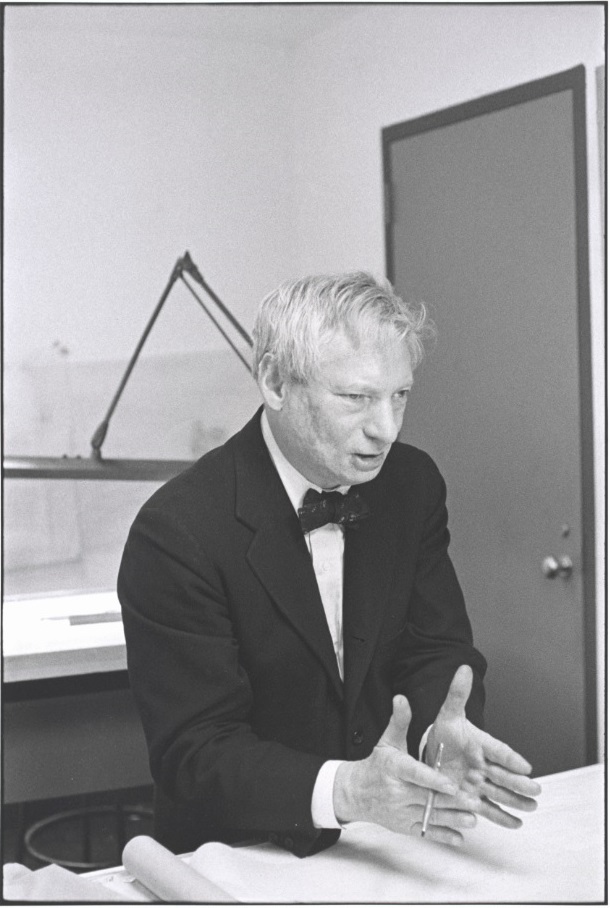
Louis Kahn the architect's architect? • V&A Blog
The Architect Louis I.Kahn. In October 1966, Louis I. Kahn (1901-1974) received the commission to design the Kimbell Art Museum. From the moment it opened in October 1972, it was deemed not only the apotheosis of Kahn's ever-evolving ideas about the architectural union of light and structure, but also one of the finest art museums ever built.

Louis Kahn, don’t stop talking! Architecture needs you more than ever
As a tribute to the vernacular architecture of India, Louis Kahn sculpted a design using local materials like brick and concrete with large geometrical cutouts on the facade that also helped in cooling down the climate by natural methods. The hallways, open plazas and the transitional areas became new centres for learning and interaction..

In “Louis Kahn The Power of Architecture,” The City Is A Muse Hidden
Louis Isadore Kahn (born Itze-Leib Schmuilowsky; March 5 [O.S. February 20] 1901 - March 17, 1974) was an Estonian-born American architect based in Philadelphia. After working in various capacities for several firms in Philadelphia, he founded his own atelier in 1935. While continuing his private practice, he served as a design critic and.
Louis Kahn's Salk Institute, the building that guesses tomorrow, is
A visionary and philosopher, Louis Kahn explored the ways in which architecture could improve lives and create harmony Article first published on Houzz. Catherine Macaulay, Houzz Contributor. Architect at a Glance Name Louis Isadore Kahn, 1901-1974 Design philosophy Kahn was interested in community life and the social responsibility of.

Architecture and Film My Architect (2003), the secret life of Louis
Louis Isadore Kahn born as Itze-Leib Schmuilowsky (February 20, 1901 or 1902 - March 17, 1974) was a world-renowned architect of Estonian origin based in Philadelphia, United States. Training and influences He trained in a rigorous Beaux-Arts tradition, with its emphasis on drawing, at the University of Pennsylvania.

Louis Isidore Kahn 20.01.1901 Saaremaa 17.03.1974 NY Le Corbusier
Louis I. Kahn Born Kuressaare, Estonia February 20, 1901 Deceased New York, United States March 17, 1974 12 Projects Four Freedoms Park Year 2010 - 2012 Place Roosevelt Island, New York, United States National Assembly of Bangladesh Year 1964-1982 Place Dakha, Bangladesh Indian Institute of Management Year 1962-1974 Place Ahmedabad, Gujarat, India

The Enduring History of Louis Kahn Architect Magazine
A master of turning simple forms and classic motifs into extraordinary monuments, American architect and professor Louis Kahn created a spartan body of work that's become hallowed ground for his peers, influencing a generation.

Pin on Louis Kahn / Portraits
Louis I. Kahn, whose strong forms of brick and concrete influenced a generation of architects and made him, in the opinion of most architectural scholars, America's foremost living.

Light Matters Louis Kahn and the Power of Shadow ArchDaily
The legendary modernist Louis Kahn was a highly influential designer and one of the most important architects of the 20th century. His work is often described as monumental because of its scale, geometries, and presence. He was also a master of material and light—a characteristic highlighted by his often simple forms and geometric moves.

Louis Kahn, American architect Stock Image C052/8002 Science
Louis I. Kahn is widely considered one of the great architects of the twentieth century, yet he has few buildings to his name. Like any great artist, Kahn's influence has never been measured by the number of projects completed but by the value of his designs. Background Born: February 20, 1901, in Kuressaare, in Estonia, on Saaremmaa Island

Louis Kahn (1972) Photograph
About Us Visiting Kahn, Louis I. Louis I. Kahn Collection (030), Architect, 1909-1974 Louis I. Kahn was born in Estonia and raised in Philadelphia. He was trained in architecture in the Beaux-Arts tradition at the University of Pennsylvania under Paul Philippe Cret.

ARQUITECTURA 4 AMETTE ASGBL Louis I. Kahn. FORMA Y DISEÑO. (1961)
ARCHITECTURE Louis I. Kahn Biography Louis Isadore Kahn was born Itze-Leib Schmuilowsky in 1901 on Osel, an island off the coast of Estonia. His family immigrated to the United States when he was four, settling in Philadelphia, where they had relatives already living nearby.

Louis Kahn To She, who was crazy, selfcentered & cruel at least I
Louis Kahn, (born February 20, 1901, Osel, Estonia, Russian Empire [now Saaremaa, Estonia]—died March 17, 1974, New York, New York, U.S.), American architect whose buildings, characterized by powerful, massive forms, made him one of the most discussed architects to emerge after World War II.

Louis Kahn Louis kahn, Louis, Portrait
Louis Kahn (February 20th 1901 - March 17th 1974) was one of the United States' greatest 20th century architects, known for combining Modernism with the weight and dignity of ancient.

Louis Kahn Extraordinary architect, complex family man The
Mr. Kahn's teaching and buildings helped spread new, modern ideas about the use of light and space in urban architecture. In 1957, Mr. Kahn embarked on a Penn building, the Richards Medical Research Laboratory, which was completed in 1960. The Alfred Newton Richards Medical Research Building was dedicated on May 19, 1960 ( Almanac June 1960 ).

By All Means Necessary My Architect or Sex is Not Enough for Fathers
Lesser gives the book an unusual structure. She begins with Kahn's death in March 1974, at age 73, of a heart attack, just outside a men's room in the bowels of Pennsylvania Station in New York, at the tail end of a trip home from India. Then she turns back to his childhood, in a working-class family in Estonia and then Philadelphia, before.